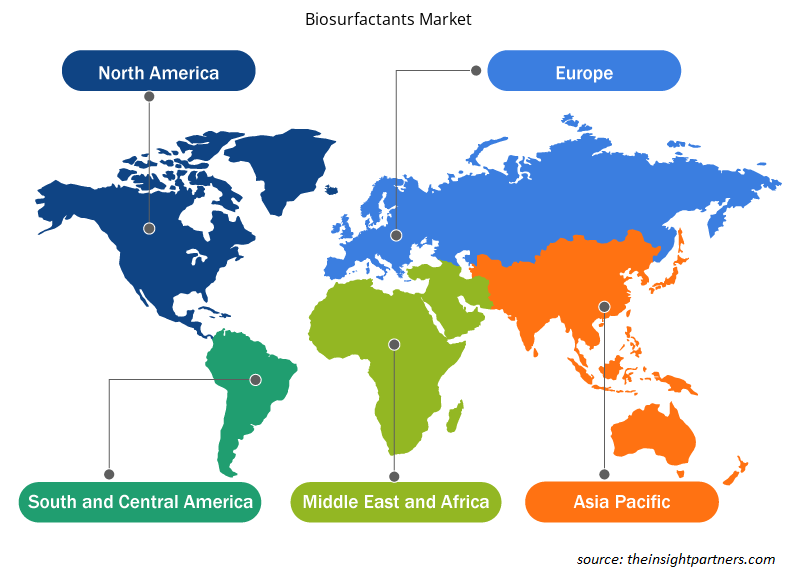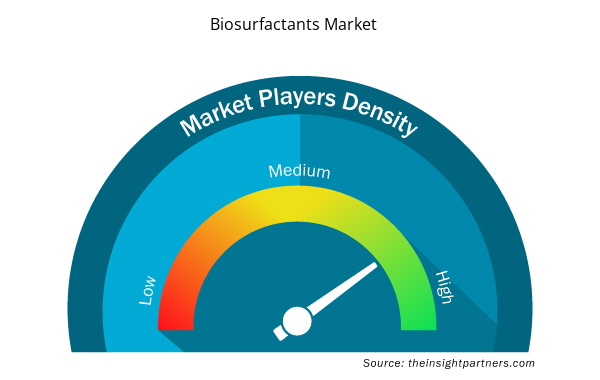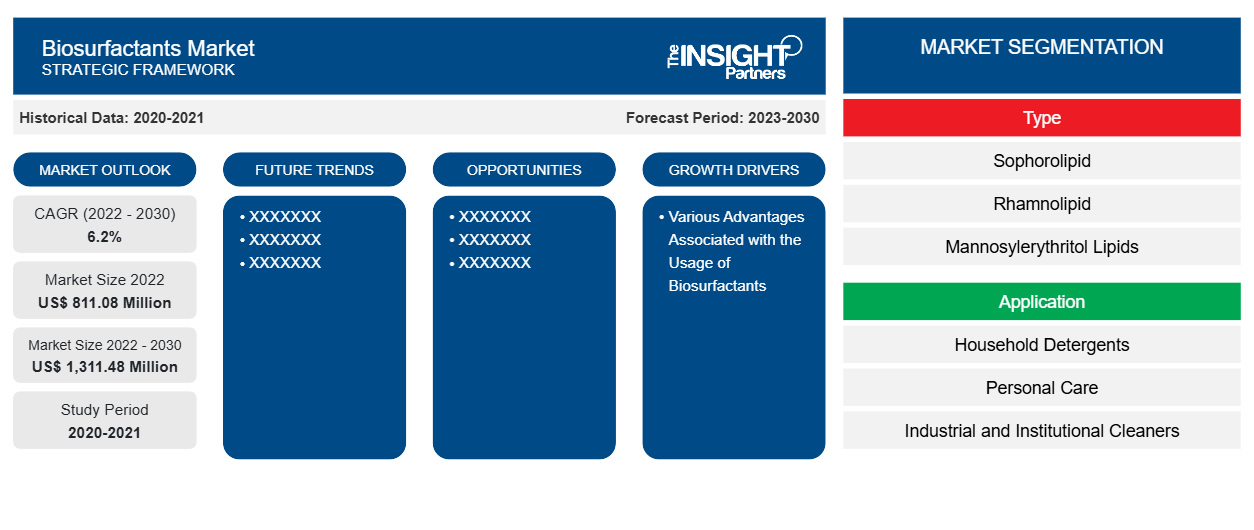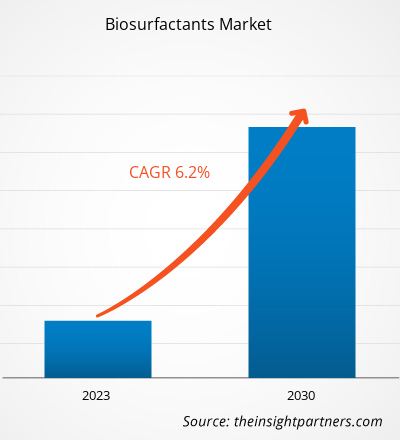[研究报告] 生物表面活性剂市场规模预计将从 2022 年的 8.1108 亿美元增长到 2030 年的 13.1148 亿美元;预计 2022 年至 2030 年的复合年增长率为 6.2%。
市场洞察和分析师观点:
生物表面活性剂是一种可通过选定数量的毒性合成的表面活性化合物。除了可生物降解、低毒性和高生产潜力外,生物表面活性剂还具有高表面和界面活性。生物表面活性剂广泛用于农业产品,如农药和其他化学品,住宅、医疗和保健用途的洗涤剂;个人护理和化妆品,如洗发水、大麻洗涤液、肥皂和许多其他产品。由于石油和能源、农业、化学、制药、医疗和保健、消费品等许多终端行业对生物表面活性剂的需求不断增加,该市场日益蓬勃发展。这一因素极大地推动了全球生物表面活性剂市场的发展
增长动力和挑战:
生物表面活性剂与化学表面活性剂相比具有多种优势,例如高生物降解性、生物特性多样性以及作为不同分子混合物合成的可再生特性。生物表面活性剂具有多种特性,包括抗菌和抗氧化活性,可应用于洗涤剂和个人护理等不同行业。它们在降低表面张力和界面张力方面也非常有效。此外,生活水平提高、人口增长、城市化进程加快、创新产品推出激增以及消费者对健康和卫生意识的提高是推动全球家用洗涤剂和清洁产品需求的关键因素。此外,市场参与者开展的各种营销活动和宣传活动提高了消费者对凝胶、凝露和液体等洗涤剂产品的认识。近年来,中国清洁产品市场稳步增长。然而,制造商在实现工业生产方面面临挑战,而工业生产对于生产生物表面活性剂而言是经济可行的。与商业合成表面活性剂相比,生物表面活性剂的产量较低,因此生产成本较高。原料成本高、净化成本高以及下游加工成本高都会影响生产成本。生物表面活性剂的主要缺点是价格昂贵,这是降低生物表面活性剂需求的一个主要因素。
定制此报告以满足您的需求
您可以免费定制任何报告,包括本报告的部分内容、国家级分析、Excel 数据包,以及为初创企业和大学提供优惠和折扣
- 获取此报告的关键市场趋势。这个免费样品将包括数据分析,从市场趋势到估计和预测。
报告细分和范围:
全球生物表面活性剂市场根据类型、应用和地域进行细分。根据类型,生物表面活性剂市场细分为槐糖脂、鼠李糖脂、甘露糖基赤藓糖醇脂质 (MEL)、烷基多糖苷 (APG)、表面活性素、磷脂、聚合物等。根据应用,生物表面活性剂市场细分为家用洗涤剂、个人护理、工业和机构清洁剂、食品加工、油田化学品、皮革加工、农业、制药等。从地域上看,市场细分为北美(美国、加拿大和墨西哥)、欧洲(德国、法国、英国、俄罗斯、意大利和欧洲其他地区)、亚太地区(韩国、澳大利亚、中国、日本、印度和亚太其他地区)、中东和非洲(阿联酋、南非、沙特阿拉伯和中东和非洲其他地区)以及南美洲和中美洲(巴西、阿根廷和南美洲和中美洲其他地区)。
节段分析:
根据类型,生物表面活性剂市场细分为槐糖脂、鼠李糖脂、甘露糖基赤藓糖醇脂质 (MEL)、烷基多糖苷 (APG)、表面活性素、磷脂、聚合物等。槐糖脂细分市场在 2022 年占据了最大的市场份额。槐糖脂是一类由酵母(主要是 Candida bombicola)产生的糖脂生物表面活性剂。这些分子具有出色的表面活性特性,使其在个人护理产品、洗涤剂、食品添加剂、药品和环境修复等各种应用中都很有价值。在化妆品中,槐糖脂作为天然和可生物降解的乳化剂和发泡剂已获得关注。它们能够稳定配方,同时对皮肤温和,这与消费者对环保和亲肤产品的日益增长的偏好相一致。根据应用,生物表面活性剂市场细分为家用洗涤剂、个人护理、工业和机构清洁剂、食品加工、油田化学品、皮革加工、农业、制药等。2022 年,家用洗涤剂在生物表面活性剂市场中的份额非常可观。生物表面活性剂在硬表面清洁和自动洗碗助剂配方中表现出色。这部分是由于它们的低泡沫特性和表面活性特性,这在其他应用中可能很有趣。它们结合了出色的环保特性和出色的效率,因此适合用于家用商业产品。
区域分析:
生物表面活性剂市场分为五个主要区域——北美、欧洲、亚太、南美和中美以及中东和非洲。欧洲主导着全球生物表面活性剂市场,该区域市场在 2022 年的规模约为 3 亿美元。北美也是一个主要贡献者,占据了全球生物表面活性剂市场份额的很大一部分。预计到 2030 年,北美市场将达到 3.4 亿美元以上。预计亚太地区在 2022 年至 2030 年的复合年增长率将超过 7%。按国家/地区划分,亚太生物表面活性剂市场分为澳大利亚、中国、印度、日本、韩国和亚太其他地区。市场受到洗涤剂和清洁产品行业需求不断增长以及对使用生物表面活性剂的优势的认识不断提高等因素的推动。这些生物相容性和环境友好的生物表面活性剂因其在个人护理、制药、农业和采油等行业的广泛应用而获得了显著的吸引力。人们对可持续和绿色技术的认识不断提高,预计将推动对生物表面活性剂的需求,因为它们能有效减少对环境的影响。此外,人们越来越关注减少对传统石化表面活性剂的依赖,这促使亚太地区的公司投资于这些生物基替代品的研究、开发和生产
生物表面活性剂市场区域洞察
Insight Partners 的分析师已详细解释了预测期内影响生物表面活性剂市场的区域趋势和因素。本节还讨论了北美、欧洲、亚太地区、中东和非洲以及南美和中美洲的生物表面活性剂市场细分和地理位置。

- 获取生物表面活性剂市场的区域特定数据
生物表面活性剂市场报告范围
| 报告属性 | 细节 |
|---|---|
| 2022 年市场规模 | 8.1108亿美元 |
| 2030 年的市场规模 | 13.1148亿美元 |
| 全球复合年增长率(2022 - 2030 年) | 6.2% |
| 史料 | 2020-2021 |
| 预测期 | 2023-2030 |
| 涵盖的领域 | 按类型
|
| 覆盖地区和国家 | 北美
|
| 市场领导者和主要公司简介 |
|
生物表面活性剂市场参与者密度:了解其对业务动态的影响
生物表面活性剂市场正在快速增长,这得益于终端用户需求的不断增长,而这些需求又源于消费者偏好的不断变化、技术进步以及对产品优势的认识不断提高等因素。随着需求的增加,企业正在扩大其产品范围,进行创新以满足消费者的需求,并利用新兴趋势,从而进一步推动市场增长。
市场参与者密度是指在特定市场或行业内运营的企业或公司的分布情况。它表明在给定市场空间中,相对于其规模或总市场价值,有多少竞争对手(市场参与者)存在。
在生物表面活性剂市场运营的主要公司有:
- 陶氏公司,
- 联合碳素解决方案有限公司
- 萨拉亚有限公司
- 赢创工业集团
- 巴斯夫
免责声明:上面列出的公司没有按照任何特定顺序排列。

- 获取生物表面活性剂市场主要参与者的概述
行业发展和未来机遇:
以下列出了生物表面活性剂市场主要参与者采取的各种举措:
- 2023 年 3 月,Holiferm Ltd 和 Sasol Ltd. 的业务部门 Sasol Chemicals 宣布合作生产和销售鼠李糖脂和甘露糖基赤藓糖醇脂质 (MEL)。此次合作扩大了两家公司于 2022 年 3 月宣布的合作伙伴关系,旨在开发和商业化另一种生物表面活性剂产品槐糖脂。
COVID-19 影响:
COVID-19 疫情影响了多个国家的各个行业。北美、欧洲、亚太地区 (APAC)、南美和中美 (SAM) 以及中东和非洲 (MEA) 的封锁、旅行限制和企业关闭阻碍了多个行业的增长,包括化学和材料行业。制造部门的关闭扰乱了全球供应链、制造活动、交付时间表以及必需品和非必需品销售。多家公司报告称,2020 年产品交付延迟,产品销售下滑。由于疫情引发的经济衰退,消费者在购买决策方面变得谨慎和挑剔。由于收入较低和收入前景不确定,消费者大幅减少了非必需品购买,尤其是在发展中地区。在疫情初期,由于消费者需求减少,许多生物表面活性剂制造商面临利润下降的问题。然而,到 2021 年底,许多国家都已全面接种疫苗,各国政府宣布放宽某些规定,包括封锁和旅行禁令。人们开始前往不同的地方,这增加了对生物表面活性剂的需求。所有这些因素都在推动不同地区生物表面活性剂市场的增长。
竞争格局和重点公司:
陶氏公司、Allied Carbon Solutions Co Ltd、Saraya Co Ltd、Evonik Industries AG、BASF SE、Sabo SPA、Holiferm Ltd、Stepan Co、Deguan Biosurfactant Supplier 和 Jeneil Bioproducts GmbH 是全球生物表面活性剂市场上的知名企业。这些企业提供高质量的生物表面活性剂,满足全球市场上众多消费者的需求。
- 历史分析(2 年)、基准年、预测(7 年)及复合年增长率
- PEST 和 SWOT 分析
- 市场规模价值/数量 - 全球、区域、国家
- 行业和竞争格局
- Excel 数据集


- Water Pipeline Leak Detection System Market
- Advanced Planning and Scheduling Software Market
- Organoids Market
- Sexual Wellness Market
- Space Situational Awareness (SSA) Market
- Educational Furniture Market
- Smart Mining Market
- Industrial Inkjet Printers Market
- Hydrocephalus Shunts Market
- Glycomics Market

Report Coverage
Revenue forecast, Company Analysis, Industry landscape, Growth factors, and Trends

Segment Covered
This text is related
to segments covered.

Regional Scope
North America, Europe, Asia Pacific, Middle East & Africa, South & Central America

Country Scope
This text is related
to country scope.
常见问题
Europe accounted for the largest share of the global biosurfactants market. Europe is one of the most significant regions for the biosurfactants market owing to drastic preference towards ecofriendly biosurfactants.
Biosurfactants offer several advantages over chemical surfactants, such as high biodegradability, diversity of biological properties, and renewable characteristics being synthesized as a mixture of different molecules. Biosurfactants have various properties, including antimicrobial and antioxidant activity, that allow their application in different industries, such as detergents and personal care. They are also highly efficient in reducing surface and interfacial tensions.
Based on type, the biosurfactants market is segmented into sophorolipid, rhamnolipid, mannosylerythritol lipids (MELs), alkyl polyglucosides (APGs), surfactin, phospholipids, polymeric, and others. The sophorolipid segment held the largest market share in 2022. Sophorolipids are a class of glycolipid biosurfactants produced by yeast, primarily Candida bombicola. These molecules possess excellent surface-active properties, making them valuable in various applications such as personal care products, detergents, food additives, pharmaceuticals, and environmental remediation.
The major players operating in the global biosurfactants market are Dow Inc, Allied Carbon Solutions Co Ltd, Saraya Co Ltd, Evonik Industries AG, BASF SE, Sabo SPA, Holiferm Ltd, Stepan Co, Deguan Biosurfactant Supplier, and Jeneil Bioproducts GmbH.
Based on application, the biosurfactants market is segmented into household detergents, personal care, industrial and institutional cleaners, food processing, oilfield chemicals, leather processing, agriculture, pharmaceuticals, and others. The biosurfactants market share for the household detergents segment was notable in 2022. Biosurfactants have shown effective results in hard surface cleaning and automated dishwashing aid formulations.
The personal care & cosmetics industry is growing significantly as people increasingly buy personal care and beauty products. In recent years, there has been a growth in the use of different cosmetic products among both male and female consumers in their daily routines. The personal care and cosmetic product manufacturers focus on product branding, advertising, and new product launch strategies to increase product sales. The e-commerce industry in many countries has been witnessing a rising growth curve, further boosting the sales of personal care and cosmetic products across the globe.
Trends and growth analysis reports related to Chemicals and Materials : READ MORE..
The List of Companies - Biosurfactants Market
- Dow Inc,
- Allied Carbon Solutions Co Ltd
- Saraya Co Ltd
- Evonik Industries AG
- BASF SE
- Sabo SPA
- Holiferm Ltd
- Stepan Co
- Deguan Biosurfactant Supplier
- Jeneil Bioproducts GmbH
The Insight Partners performs research in 4 major stages: Data Collection & Secondary Research, Primary Research, Data Analysis and Data Triangulation & Final Review.
- Data Collection and Secondary Research:
As a market research and consulting firm operating from a decade, we have published and advised several client across the globe. First step for any study will start with an assessment of currently available data and insights from existing reports. Further, historical and current market information is collected from Investor Presentations, Annual Reports, SEC Filings, etc., and other information related to company’s performance and market positioning are gathered from Paid Databases (Factiva, Hoovers, and Reuters) and various other publications available in public domain.
Several associations trade associates, technical forums, institutes, societies and organization are accessed to gain technical as well as market related insights through their publications such as research papers, blogs and press releases related to the studies are referred to get cues about the market. Further, white papers, journals, magazines, and other news articles published in last 3 years are scrutinized and analyzed to understand the current market trends.
- Primary Research:
The primarily interview analysis comprise of data obtained from industry participants interview and answers to survey questions gathered by in-house primary team.
For primary research, interviews are conducted with industry experts/CEOs/Marketing Managers/VPs/Subject Matter Experts from both demand and supply side to get a 360-degree view of the market. The primary team conducts several interviews based on the complexity of the markets to understand the various market trends and dynamics which makes research more credible and precise.
A typical research interview fulfils the following functions:
- Provides first-hand information on the market size, market trends, growth trends, competitive landscape, and outlook
- Validates and strengthens in-house secondary research findings
- Develops the analysis team’s expertise and market understanding
Primary research involves email interactions and telephone interviews for each market, category, segment, and sub-segment across geographies. The participants who typically take part in such a process include, but are not limited to:
- Industry participants: VPs, business development managers, market intelligence managers and national sales managers
- Outside experts: Valuation experts, research analysts and key opinion leaders specializing in the electronics and semiconductor industry.
Below is the breakup of our primary respondents by company, designation, and region:

Once we receive the confirmation from primary research sources or primary respondents, we finalize the base year market estimation and forecast the data as per the macroeconomic and microeconomic factors assessed during data collection.
- Data Analysis:
Once data is validated through both secondary as well as primary respondents, we finalize the market estimations by hypothesis formulation and factor analysis at regional and country level.
- Macro-Economic Factor Analysis:
We analyse macroeconomic indicators such the gross domestic product (GDP), increase in the demand for goods and services across industries, technological advancement, regional economic growth, governmental policies, the influence of COVID-19, PEST analysis, and other aspects. This analysis aids in setting benchmarks for various nations/regions and approximating market splits. Additionally, the general trend of the aforementioned components aid in determining the market's development possibilities.
- Country Level Data:
Various factors that are especially aligned to the country are taken into account to determine the market size for a certain area and country, including the presence of vendors, such as headquarters and offices, the country's GDP, demand patterns, and industry growth. To comprehend the market dynamics for the nation, a number of growth variables, inhibitors, application areas, and current market trends are researched. The aforementioned elements aid in determining the country's overall market's growth potential.
- Company Profile:
The “Table of Contents” is formulated by listing and analyzing more than 25 - 30 companies operating in the market ecosystem across geographies. However, we profile only 10 companies as a standard practice in our syndicate reports. These 10 companies comprise leading, emerging, and regional players. Nonetheless, our analysis is not restricted to the 10 listed companies, we also analyze other companies present in the market to develop a holistic view and understand the prevailing trends. The “Company Profiles” section in the report covers key facts, business description, products & services, financial information, SWOT analysis, and key developments. The financial information presented is extracted from the annual reports and official documents of the publicly listed companies. Upon collecting the information for the sections of respective companies, we verify them via various primary sources and then compile the data in respective company profiles. The company level information helps us in deriving the base number as well as in forecasting the market size.
- Developing Base Number:
Aggregation of sales statistics (2020-2022) and macro-economic factor, and other secondary and primary research insights are utilized to arrive at base number and related market shares for 2022. The data gaps are identified in this step and relevant market data is analyzed, collected from paid primary interviews or databases. On finalizing the base year market size, forecasts are developed on the basis of macro-economic, industry and market growth factors and company level analysis.
- Data Triangulation and Final Review:
The market findings and base year market size calculations are validated from supply as well as demand side. Demand side validations are based on macro-economic factor analysis and benchmarks for respective regions and countries. In case of supply side validations, revenues of major companies are estimated (in case not available) based on industry benchmark, approximate number of employees, product portfolio, and primary interviews revenues are gathered. Further revenue from target product/service segment is assessed to avoid overshooting of market statistics. In case of heavy deviations between supply and demand side values, all thes steps are repeated to achieve synchronization.
We follow an iterative model, wherein we share our research findings with Subject Matter Experts (SME’s) and Key Opinion Leaders (KOLs) until consensus view of the market is not formulated – this model negates any drastic deviation in the opinions of experts. Only validated and universally acceptable research findings are quoted in our reports.
We have important check points that we use to validate our research findings – which we call – data triangulation, where we validate the information, we generate from secondary sources with primary interviews and then we re-validate with our internal data bases and Subject matter experts. This comprehensive model enables us to deliver high quality, reliable data in shortest possible time.


 获取此报告的免费样本
获取此报告的免费样本